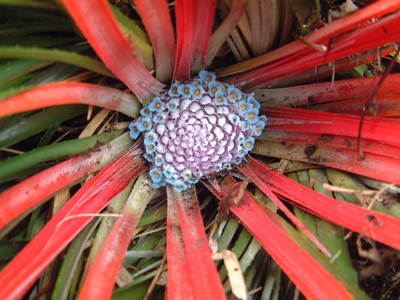|
|
|
Few
bromeliads are hardy in our temperate climate but one
notable exception is Fascicularia. Perhaps more
remarkable, for a genus in the a mostly tropical family
of plants, is their late flowering, usually in October
and November in the British Isles,
There
are two plants of this Chilean genus that are quite
common in cultivation, widely known as F.bicolor
and F.pitcairnifolia. The former has a more
southerly habitat range, where it is often epiphytic,
and is reliably hardy in cultivation. The latter is more
northerly in its distribution, and thus less hardy
though there is a considerable overlap in their habitat
ranges. Both plants are remarkably drought
resistant and in time will expand into sizeable
colonies, thought they are relatively slow to increase..
|
|
|
 |
|
Fascicularia
bicolor
|
|
| This
genus from Chile was established by the Spanish
botanists Ruiz
and Pavon, in their 3 Volume Magnus Opus ‘Flora
peruviana et chilensis’, plus two supplements,
1796-1802. They established the genus with Fascicularia
bicolor which unlike so many other plants that they
discovered and named, was neither illustrated, nor
described in great detail, and no herbarium specimen of
it survives from their expedition.
|
| In
1997, in the New Plantsman Vol.4 pt.4, Dr Charles
Nelson and Professor Zizka, published an article
reclassifying the genus, in which they determined that
the plant that Ruiz & Pavon had named F.bicolor
was more likely to be the plant known as F.pitcairnifolia.
|
|
|
|
They reclassified it as F.bicolor and the plant
in cultivation for well over 100 years as F.bicolor
and F.bicolor subsp. canaliculata. There are a
number of significant flaws in the article, and it is
certainly arguable that there are sufficient differences
between the plants to maintain them as separate species,
though that would create a hiatus in the already
convoluted nomenclature changes. |
|
It
will be some time before the names of the two plants is
finally resolved, and ironically, in the small collection
of these plants that Charles Nelson established at
Glasnevin they are still labelled under the long established
names, though unfortunately the wrong way around!
|
|
 |
|
Fascicularia
pitcairnifolia.
|
|
|
|
The
old familiar names are used in the accompanying
photographs. F.bicolor has thin channelled
leaves and the flower head develops completely before
the pale blue flowers begin to open in sequence from
the outer perimeter gradually moving to the centre. F.pitcairnifolia
has thicker, and fleshier leaves, which are often
broader and the deep blue flowers emerge and open from
the centre as the flower head expands.
|
|
|
|
|
|
|
|
|
|
|
|
|
